
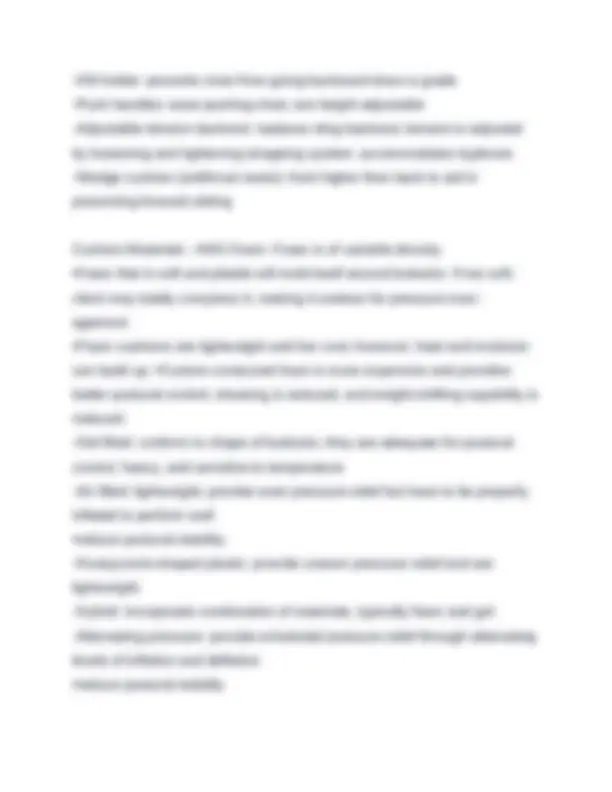
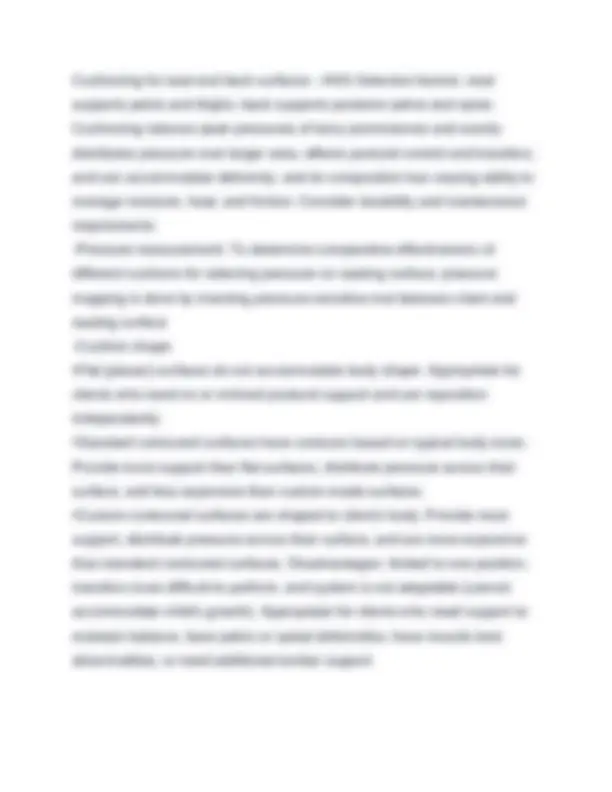
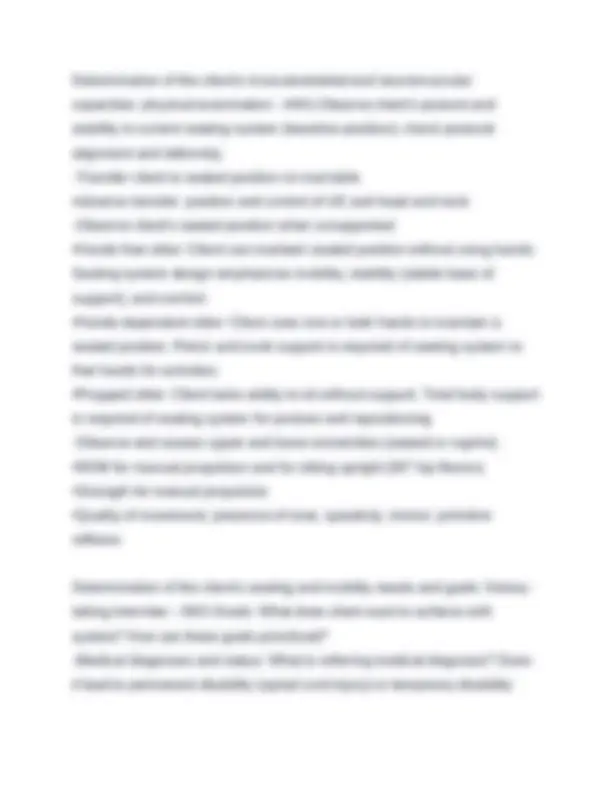
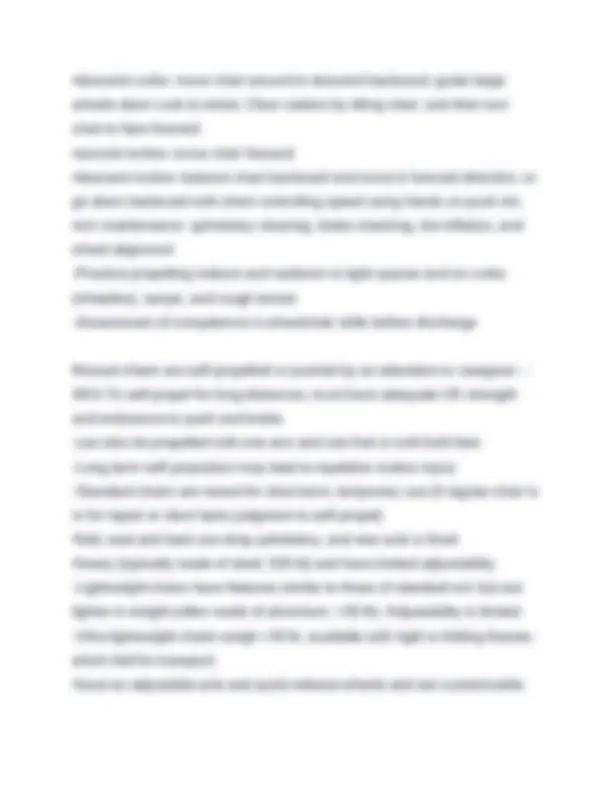
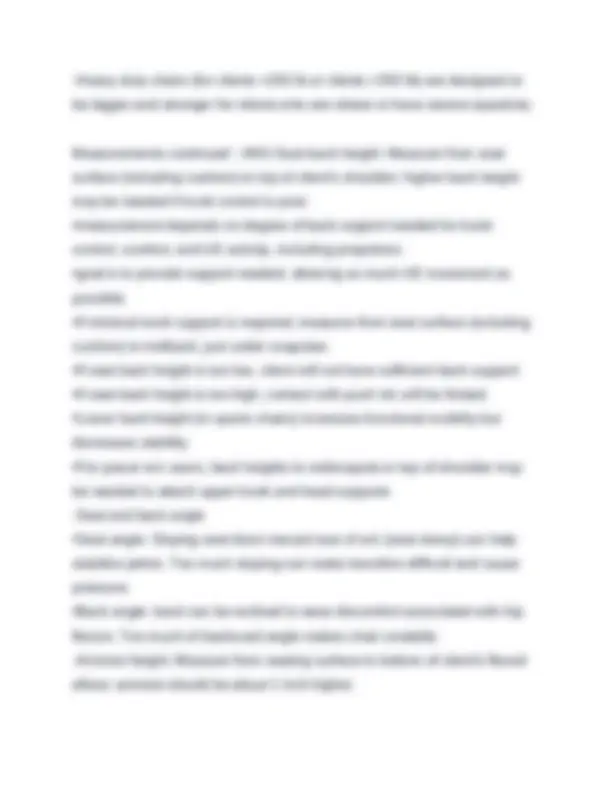
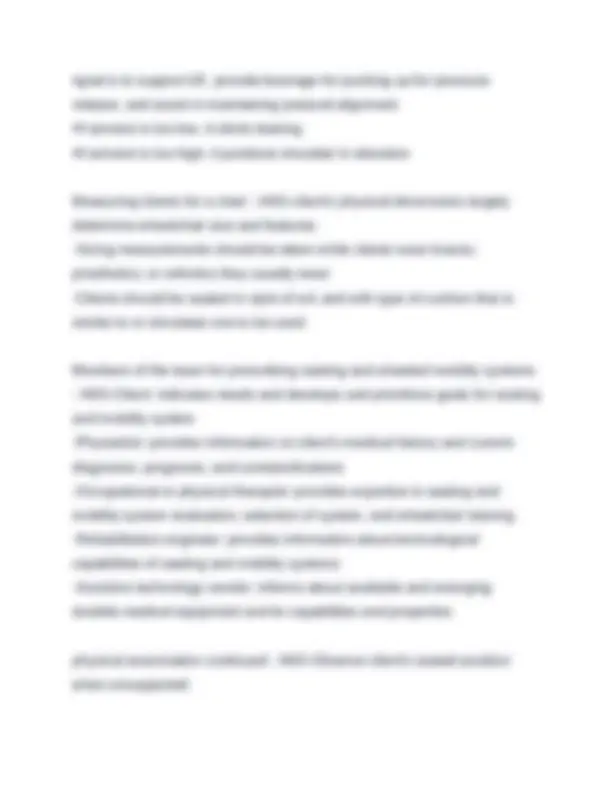
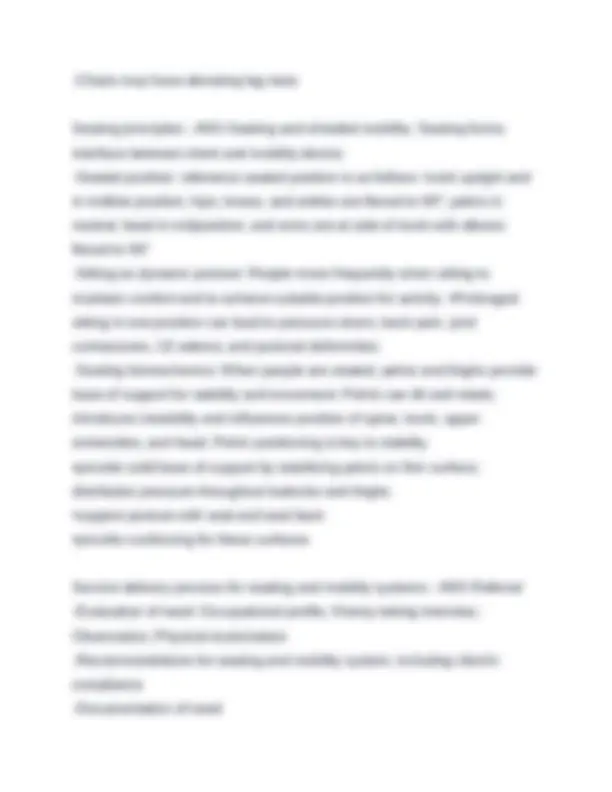
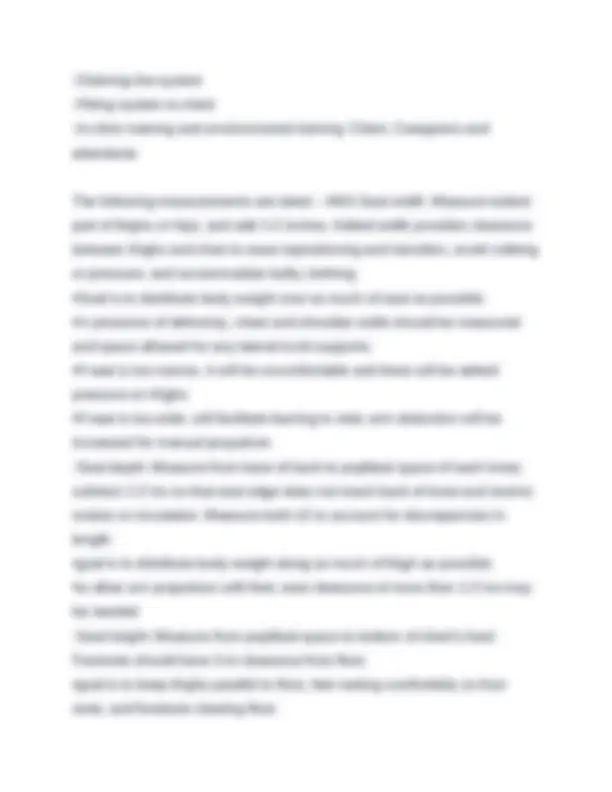
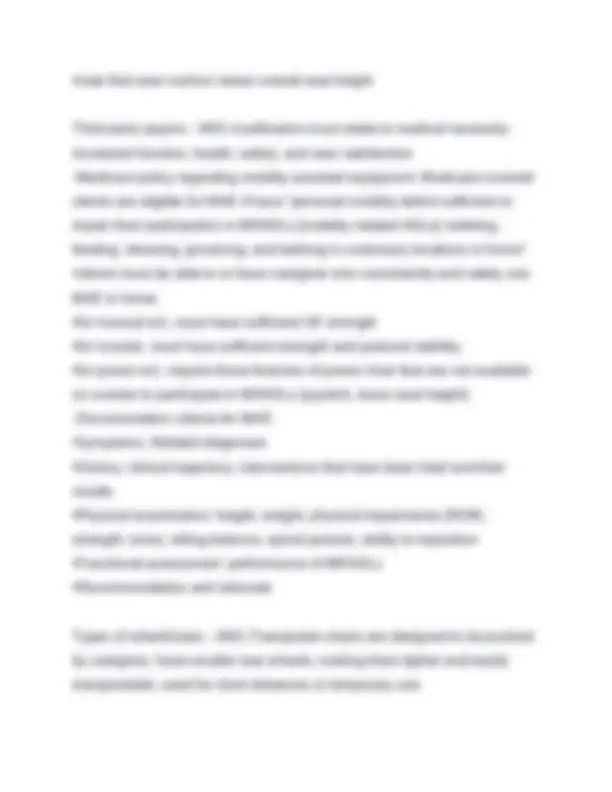
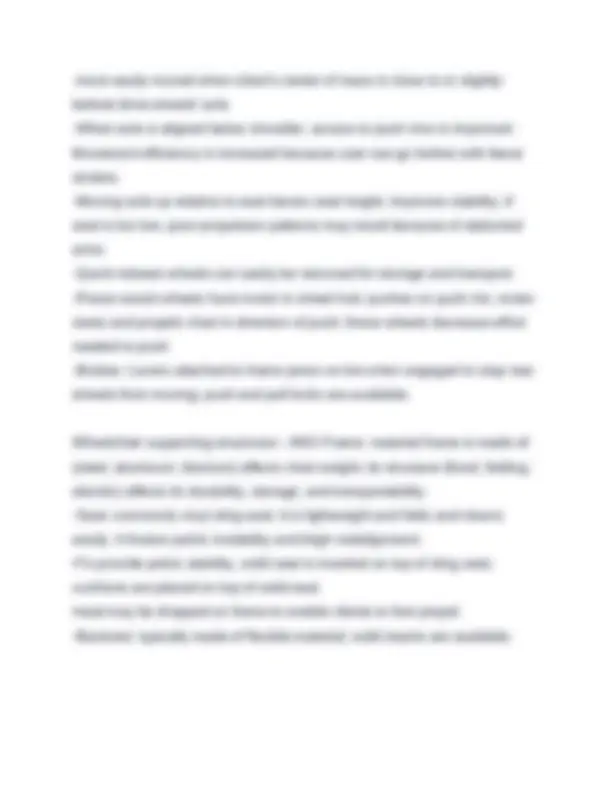


Study with the several resources on Docsity

Earn points by helping other students or get them with a premium plan


Prepare for your exams
Study with the several resources on Docsity

Earn points to download
Earn points by helping other students or get them with a premium plan
Community
Ask the community for help and clear up your study doubts
Discover the best universities in your country according to Docsity users
Free resources
Download our free guides on studying techniques, anxiety management strategies, and thesis advice from Docsity tutors
Wheelchair Seating and Mobility Test 2025-2026. Questions & Correct Answers. Graded A
Typology: Exams
1 / 18

This page cannot be seen from the preview
Don't miss anything!











Additional seating supports – ANS -pelvic stabilizer (belt, SubASIS bar) is positioned at front of pelvis to limit pelvic tilt, rotation, or obliquity. -Thoracic supports are placed lateral to trunk and below armpit to facilitate trunk stability and prevent or slow scoliosis; anterior trunk supports are situated below top and above bottom of breastbone. -Thigh supports are placed lateral or medial to thighs to control abduction or adduction (windswept deformity). -head rest supports back of head and is positioned at the occiput. Chairs for specific populations - ANS-One-arm drive chairs are for clients with hemiplegia or one arm amputated. Axles are linked to allow both wheels to operate from one side. -Hemi-height chairs are for clients with hemiplegia. Chair height is lower to permit foot propelling. Foot rest for nonhemiplegic extremity is removed. -Extra heavy-duty chairs are for clients who are obese and need larger, stronger chairs (rated for weight >300 lb) to accommodate their weight. Compared with standard chairs, rear axle is displaced forward, have hard, extra wide tires. -Pediatric chairs are designed for dimensions of children and for accommodating growth.
-Amputee chairs, because amputation moves client's center of gravity back when seated, have rear axle set back to increase stability, which compensates for loss of weight of missing limb or limbs. -Sports chairs are very lightweight chairs (<20 lb) designed for specific sports. Characteristics of clients requiring support for mobility - ANS-Marginal ambulatory user: can walk short distances; may need w/c on occasion, especially outdoors; can benefit from intermittent use of power mobility device such as a scooter -Manual wheelchair user: can propel manual w/c with both UE, both LE, or one upper and one lower extremity or is pushed by caregiver -Marginal manual wheelchair user: can propel manual w/c for short distances; tolerates only limited use because of UE overuse injury, upper body weakness, lack of endurance, or respiratory problems; may at times use a manual or power wheelchair -Totally or severely mobility-impaired user: is unable to self-propel a manual wheelchair; is dependent on a power chair or attendant Common wheelchair accessories - ANS-Lapboard: Fits across armrests to support weak UE or provide a work surface •wraps around client; reduces overall width of chair by about 1 inch -Positioning belt: stabilizes pelvis; should be positioned so that it pulls on pelvis at a 45° angle to base of seat back -Hand rim projections: compensate for weak grasp in moving wheelchair -Brake lever extender: compensates for limited ROM in reaching brakes -Antitip devices: prevent from tipping backward
Cushioning for seat and back surfaces - ANS-Selection factors: seat supports pelvis and thighs; back supports posterior pelvis and spine. Cushioning reduces peak pressures of bony prominences and evenly distributes pressure over larger area, affects postural control and transfers, and can accommodate deformity, and its composition has varying ability to manage moisture, heat, and friction. Consider durability and maintenance requirements. -Pressure measurement: To determine comparative effectiveness of different cushions for relieving pressure on seating surface, pressure mapping is done by inserting pressure-sensitive mat between client and seating surface -Cushion shape: •Flat (planar) surfaces do not accommodate body shape. Appropriate for clients who need no or minimal postural support and can reposition independently. •Standard contoured surfaces have contours based on typical body sizes. Provide more support than flat surfaces, distribute pressure across their surface, and less expensive than custom-made surfaces. •Custom-contoured surfaces are shaped to client's body. Provide most support, distribute pressure across their surface, and are more expensive than standard contoured surfaces. Disadvantages: limited to one position, transfers more difficult to perform, and system is not adaptable (cannot accommodate child's growth). Appropriate for clients who need support to maintain balance, have pelvic or spinal deformities, have muscle tone abnormalities, or need additional lumbar support
Determination of the client's musculoskeletal and neuromuscular capacities: physical examination - ANS-Observe client's posture and stability in current seating system (baseline position); check postural alignment and deformity. -Transfer client to seated position on mat table •observe transfer: position and control of UE and head and neck -Observe client's seated position when unsupported: •Hands-free sitter: Client can maintain seated position without using hands. Seating system design emphasizes mobility, stability (stable base of support), and comfort. •Hands-dependent sitter: Client uses one or both hands to maintain a seated position. Pelvic and trunk support is required of seating system to free hands for activities. •Propped sitter: Client lacks ability to sit without support. Total body support is required of seating system for posture and repositioning -Observe and assess upper and lower extremities (seated or supine). •ROM for manual propulsion and for sitting upright (90° hip flexion) •Strength for manual propulsion •Quality of movement, presence of tone, spasticity, tremor, primitive reflexes Determination of the client's seating and mobility needs and goals: history- taking interview - ANS-Goals: What does client want to achieve with system? How are these goals prioritized? -Medical diagnoses and status: What is referring medical diagnosis? Does it lead to permanent disability (spinal cord injury) or temporary disability
Goals for seating and wheeled mobility systems - ANS-Bodily structures and function: improve skeletal alignment; prevent, reduce, or accommodate deformity; preserve skin integrity; maintain physiological function of vital organs (respiratory, circulatory) -Function: enable sitting (postural control and stability) and wheeled mobility, increase comfort (decrease discomfort or pain), normalize muscle tone, position head for visual input, decrease fatigue -Activity and participation: enhance movement to enable or optimize participation in self-care, educational, work, and play and leisure occupations; promote social acceptance and self-esteem Instruction topics for client and caregiver-attendant - ANS-Proper sitting posture, including placement of any supports -Pressure relief: Push-ups, Side-to-side movement, Schedule for weight shifts and skin monitoring -Wheelchair propulsion: Manual, Power -Safety considerations for client and caregiver-attendant: •setting and releasing brakes during transfers •swinging away leg rests (footrests); not standing on footrests •removing armrests (if appropriate) •recovery from a fall -Safety considerations for caregiver-attendant: •when pushing, make sure arms, hands, and feet are secure. •ascend curbs: tilt chair backward to lift casters onto curb, then push forward until large rear wheels roll over curb.
•descend curbs: move chair around to descend backward; guide large wheels down curb to street. Clear casters by tilting chair; and then turn chair to face forward. •ascend incline: move chair forward. •descend incline: balance chair backward and move in forward direction, or go down backward with client controlling speed using hands on push rim. •w/c maintenance: upholstery cleaning, brake checking, tire inflation, and wheel alignment -Practice propelling indoors and outdoors in tight spaces and on curbs (wheelies), ramps, and rough terrain -Assessment of competence in wheelchair skills before discharge Manual chairs are self-propelled or pushed by an attendant or caregiver. - ANS-To self-propel for long distances, must have adequate UE strength and endurance to push and brake. -can also be propelled with one arm and one foot or with both feet. -Long-term self-propulsion may lead to repetitive motion injury. -Standard chairs are meant for short-term, temporary use (if regular chair is in for repair or client lacks judgment to self-propel) •fold, seat and back are sling upholstery, and rear axle is fixed. •heavy (typically made of steel; 335 lb) and have limited adjustability. -Lightweight chairs have features similar to those of standard w/c but are lighter in weight (often made of aluminum; <35 lb). Adjustability is limited. -Ultra lightweight chairs weigh <30 lb, available with rigid or folding frames, which fold for transport. •have an adjustable axle and quick-release wheels and are customizable.
•goal is to support UE, provide leverage for pushing up for pressure release, and assist in maintaining postural alignment. •If armrest is too low, it elicits leaning. •If armrest is too high, it positions shoulder in elevation Measuring clients for a chair - ANS-client's physical dimensions largely determine wheelchair size and features. -Sizing measurements should be taken while clients wear braces, prosthetics, or orthotics they usually wear. -Clients should be seated in style of w/c and with type of cushion that is similar to or simulates one to be used. Members of the team for prescribing seating and wheeled mobility systems
•Hands-free sitter: Client can maintain a seated position without using hands. Seating system design emphasizes mobility, stability (stable base of support), and comfort. •Hands-dependent sitter: Client uses one or both hands to maintain seated position. Pelvic and trunk support is required of seating system to free hands for activities. •Propped sitter: Client lacks ability to sit without support. Total body support is required of seating system for posture and repositioning. -Observe position of client's pelvis and trunk. If deformities exist, apply manual pressure to determine whether deformity is flexible or inflexible •flexible deformity can be reduced to some extent by supportive seating system; inflexible or fixed deformity needs to be accommodated with seating system. •Pelvic obliquity: One side of pelvis is lower than other side, can lead to scoliotic posture and pressure ulcers on ischial tuberosity. •Kyphosis: pelvis rotates posteriorly, resulting in sacral sitting and flexion of lumbar spine; clients tend to slide forward on seat. •Scoliosis: pelvis rotates to one side, resulting in spine and trunk moving to opposite side. •Lordosis: pelvis rotates anteriorly, increasing curvature of lumbar spine; clients tend to use UE for support. •Windswept deformity: pelvis rotates laterally, with thighs moving to other side -Reposition client in supine •reassess pelvic and spinal alignment because influence of gravity on body is different in supine than in a seated position.
-Chairs may have elevating leg rests Seating principles - ANS-Seating and wheeled mobility: Seating forms interface between client and mobility device. -Seated position: reference seated position is as follows: trunk upright and in midline position; hips, knees, and ankles are flexed to 90°; pelvis in neutral; head in midposition; and arms are at side of trunk with elbows flexed to 90° -Sitting as dynamic posture: People move frequently when sitting to maintain comfort and to achieve suitable position for activity. •Prolonged sitting in one position can lead to pressure ulcers, back pain, joint contractures, LE edema, and postural deformities. -Seating biomechanics: When people are seated, pelvis and thighs provide base of support for stability and movement. Pelvis can tilt and rotate, introduces instability and influences position of spine, trunk, upper extremities, and head. Pelvic positioning is key to stability •provide solid base of support by stabilizing pelvis on firm surface, distributes pressure throughout buttocks and thighs. •support posture with seat and seat back •provide cushioning for these surfaces Service delivery process for seating and mobility systems - ANS-Referral -Evaluation of need: Occupational profile, History-taking interview, Observation, Physical examination -Recommendations for seating and mobility system, including client's compliance -Documentation of need
-Ordering the system -Fitting system to client -In-clinic training and environmental training: Client, Caregivers and attendants The following measurements are taken - ANS-Seat width: Measure widest part of thighs or hips, and add 1-2 inches. Added width provides clearance between thighs and chair to ease repositioning and transfers, avoid rubbing or pressure, and accommodate bulky clothing. •Goal is to distribute body weight over as much of seat as possible. •In presence of deformity, chest and shoulder width should be measured and space allowed for any lateral trunk supports. •If seat is too narrow, it will be uncomfortable and there will be added pressure on thighs. •If seat is too wide, will facilitate leaning to side; arm abduction will be increased for manual propulsion -Seat depth: Measure from base of back to popliteal space of each knee; subtract 1-2 ins so that seat edge does not reach back of knee and restrict motion or circulation. Measure both LE to account for discrepancies in length. •goal is to distribute body weight along as much of thigh as possible. •to allow w/c propulsion with feet, seat clearance of more than 1-2 ins may be needed -Seat height: Measure from popliteal space to bottom of client's heel. Footrests should have 2-in clearance from floor. •goal is to keep thighs parallel to floor, feet resting comfortably on foot- rests, and footrests clearing floor.
-Scooters are for clients whose walking ability is limited. Scooters have three (usual) or four wheels and are steered with a tiller. Do not look like w/c and are more difficult to steer than power w/c •have large turning radius, and seat swivels, may make transfers easier, have limited adjustability -Chairs that stand enable clients to be totally supported while standing and can be manual or power. Benefits are as follows: •Physiological: Standing improves circulation and bowel and bladder functions, reduces LE spasticity, and provides pressure relief. •Functional: can more easily reach items higher than seated level. Independence is increased, and some home and work adaptations may be avoided. •Social: Person-to-person interactions can occur at face-to-face level, has psychological benefit Wheelchair components - ANS-Armrests: support arms and facilitate push- ups for pressure release •fixed part of frame and provide stable surface for push-ups. Removable armrests facilitate side transfers and use of transfer board and improve access to work surfaces. •height-adjustable armrests promote comfort; if too high or too low, may cause upper body discomfort •full-length armrests provide more support for arms and better support for lap tray than shorter ones; promote ease of arm use for transfers •desk-length armrests have shorter length to improve access to work surfaces; by reversing armrest, lapboard can easily be accommodated -Leg rests and footrests (front rigging):
•fixed part of the frame. •swing-back and removable leg rests and footrests provide clear path for transfers; allow feet to reach floor to prepare for transfers. •may flip up and down, may be angle adjustable. •may adjust to different leg lengths. •elevating leg rests and footrests permit repositioning for comfort; however, because LE need to be above heart for edema control, provide little benefit for edema control. •ankle straps keep feet from slipping off footrests. •heel loops prevent feet from slipping off back of footrests. Wheelchair propelling structure - ANS-Rear wheels: usually larger wheels; equipped with push rims. -Tires may be rubber (little maintenance) or pneumatic or semipneumatic (air filled); tires absorb shock and require maintenance to keep filled with air. -Rear wheels: attached to frame with fixed or adjustable (forward- backward, up-down) axle. -Casters: smaller wheels, usually rubber, located on front of chair. •rotate freely, making steering feasible. •larger casters give more comfortable ride; less likely to get stuck in a hole. -Clients apply forward or backward motion to push rims with UE to propel chair; braking is done by applying pressure to push rims or dragging feet. -Stability and maneuverability of w/c is affected by position of drive wheels' axle in relation to client's center of gravity. -chair is more stable when client's center of mass is ahead of drive wheels' axle.